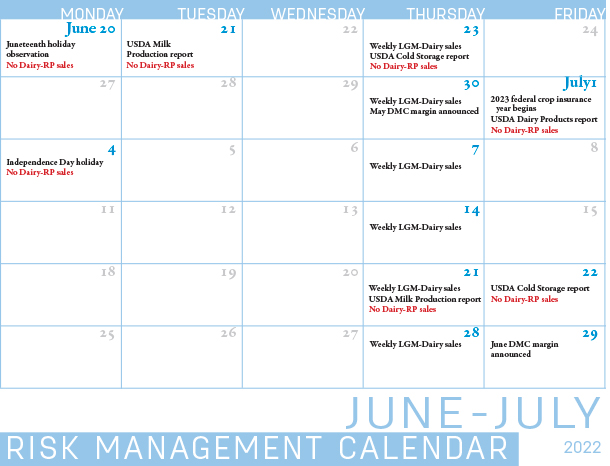Progressive Dairy provides monthly online updates of important dates, reports and advice affecting risk management decisions.
Following up on last month’s Progressive Dairy risk management calendar update (Read: May-June dairy risk management calendar: Participation levels examined) the end of June also marks the end of a federal Risk Management Agency (RMA) crop insurance year, which runs from July 1-June 30 each year.
Thus, July 1 is an important date for a couple of reasons. On that date, Dairy Revenue Protection (Dairy-RP) and Livestock Gross Margin for Dairy (LGM-Dairy) program participants can cancel policies or transfer policies to another approved insurance provider (AIP), if they choose.
Producers may have Dairy-RP and LGM-Dairy policies in effect for the same crop year, but only one policy, either Dairy-RP or LGM-Dairy, can have endorsements in effect for the same insurance period.
Once selecting an AIP, all quarterly Dairy-RP or LGM-Dairy coverage endorsements must be purchased through the same AIP within the same crop year. Cancellation during a crop year to submit an application for another Dairy-RP or LGM-Dairy policy with a different insurance provider within the same crop year is not allowed.
Dairy-RP and LGM-Dairy are available for purchase from certified insurance agents. Listing are available using the agent locator tool on the RMA website.
As outlined last month, a change is coming to Dairy-RP on July 1 with the addition of “natural disaster” coverage flexibility. The revision is applicable for the 2023 USDA crop insurance year and succeeding crop years.
Under Dairy-RP, producers are obligated to market 85% of the covered milk volume or 90% of the components to receive full indemnity payments. However, in the event of a natural disaster, those mandatory milk production thresholds may not be reached.
If a natural disaster prevents the marketing of milk, affected producers can use records as of the date of the disaster to estimate the milk marketings for the insurance period, provided they give the AIP written notice within 72 hours of the disaster. If the event occurred prior to the start of the insurance period, the insured producer may use milk marketing records from previous insurance periods to estimate marketings for the affected period.
Natural disasters include tornados, fires, floods, severe storm damage or earthquakes. The provision does not insure against the death or other loss or destruction of dairy cattle. Additionally, any impact to herd health that affects milk production would need to be tied to the natural disaster.
For more information, read: Dairy-RP adding ‘natural disaster’ coverage flexibility.
The RMA has updated Dairy-RP policy changes and handbook and LGM-Dairy policy changes and handbook for the new crop insurance year.
Policy reminders
At any one time, Dairy-RP sales are open for as many as five future quarters. Sales close 15 days before the beginning of the quarter. For example, the period to purchase Dairy-RP coverage for the third quarter of 2022 closed on June 15. The market changes daily and Dairy-RP endorsements must be purchased between the Chicago Mercantile Exchange (CME) market closing and the next CME opening.
Dairy-RP coverage cannot be purchased on days when major USDA dairy reports are released that could impact markets, including Milk Production, Cold Storage and Dairy Product reports (see Calendar). Dairy-RP is also not available on days when applicable futures contracts move limit-up or limit-down, or on days when CME trading is closed due to holidays.
LGM-Dairy provides protection when feed costs rise or milk prices drop and can be tailored to any size farm. LGM-Dairy uses futures prices for corn, soybean meal and milk to determine the expected gross margin and the actual gross margin. LGM Dairy is similar to buying both a call option to limit higher feed costs and a put option to set a floor on milk prices.
Coverage can be purchased on expected milk marketings over a rolling 11-month insurance period. For example, the insurance period for the Jan. 29 sales closing date contains the months of February through December. Coverage begins the second month of the insurance period, so the coverage period for this example is March through December.
Sales periods for the LGM-Dairy program are open on a weekly basis. Unlike Dairy-RP, LGM-Dairy is available even if a sales period falls on the day of a USDA report.
Click here or on the calendar above to view it at full size in a new window.
DMC update
Record-high milk prices offset higher feed costs in April, improving monthly dairy producer milk income over feed cost margins calculated under the Dairy Margin Coverage (DMC) program. The April DMC margin was $12.29 per hundredweight (cwt), above the top Tier I insurable level of $9.50 per cwt.
The April 2022 announced U.S. average milk price rose $1.20 from March to $27.10 per cwt, another new record high. While the news was good on the milk income side of the ledger, total feed costs also moved to another record high, pushed by prices for corn and alfalfa hay. Read: April DMC margin hits $12.29 per cwt.
May’s DMC margin will be announced on June 29.
USDA milk production report, outlook
Monthly U.S. milk production was below year-ago levels for a fourth consecutive month in April, with cow numbers lower than a year earlier and output per cow unchanged.
Read: April 2022 milk production down from a year ago.
The USDA’s preliminary May milk production estimate will be released June 21. Check the Progressive Dairy website late that day for a summary.
The USDA’s monthly World Ag Supply and Demand Estimates (WASDE) report, released June 10, revised the 2022-23 U.S. milk production estimates lower due to slower growth in milk per cow than previously expected. With the outlook for production lowered, projected farm-level milk prices were raised for both years.
The USDA cut the 2022 milk production forecast by 300 million pounds to 226.4 billion pounds. If realized, 2022 production would be up just 100 million pounds from 2021. Projected 2022 annual average price are: Class III – $22.90 per cwt, Class IV – $24.65 per cwt and all-milk – $26.20 per cwt.
For 2023, the USDA projected milk production at 229.3 billion pounds. If realized, 2023 production would be up about 1.3% from the 2022 estimate.
Prices were forecast higher for cheese, butter and nonfat milk, with the price for dry whey unchanged. Projected 2023 annual average prices are: Class III – $20.65 per cwt; Class IV – $21.90 per cwt; and all-milk – $23.80 per cwt.
For more, read: USDA cuts 2022-23 milk production forecasts, raises price projections.
Other resources
- Zach Myers, risk education manager with the Pennsylvania Center for Dairy Excellence (CDE), will host the next “Protecting Your Profits” webinar, June 22, 12-1 p.m. (Eastern time).
Myers will highlight the latest Class III and IV futures milk price forecasts and share updates on DMC margins and the Dairy-RP program.
Advance registration is not necessary. Each webinar is available via podcast or phone. To participate, click here or phone: (646) 558-8656. When prompted, enter meeting ID 848 3416 1708 and passcode 474057.
- A Dairy-RP workshop has been scheduled for July 20, 10 a.m-noon (Eastern time), at the Iredell County Extension Center, Statesville, North Carolina. Christine Brodeur, senior director of Dairy Farmer of America Risk Management, will provide Dairy-RP information and discuss economic topics affecting dairy markets around the world. Advance registration is requested.
- Federal Milk Marketing Order (FMMO) uniform price and producer price differentials for May milk marketings were released, June 9-14. May 2022 uniform milk prices set new record highs. Even though the Class III-IV price spread narrowed to an eight-month low, Class IV milk came back to the FMMO but Class III depooling increased. Read: May FMMO uniform prices set new record highs but pooling swing returns.







